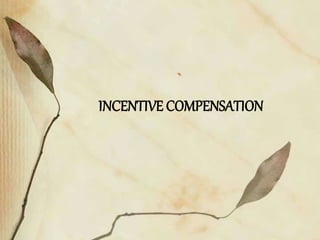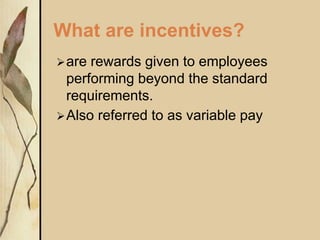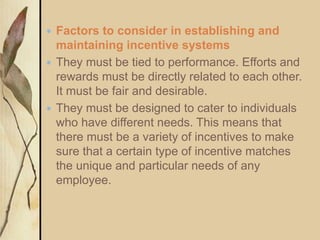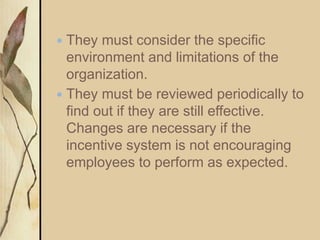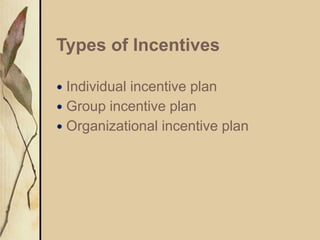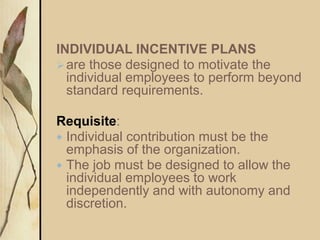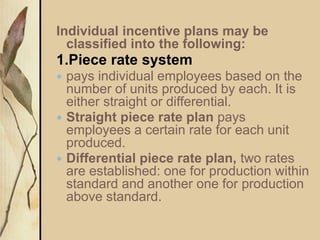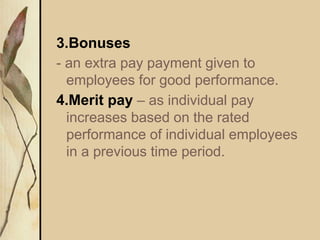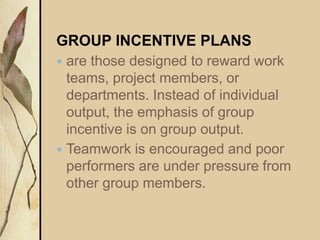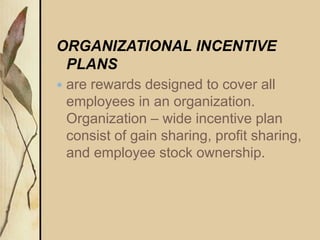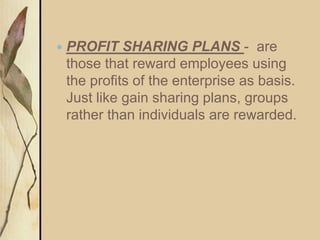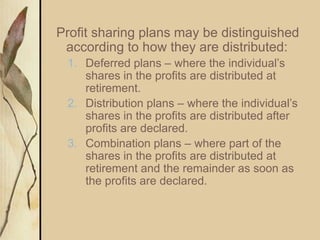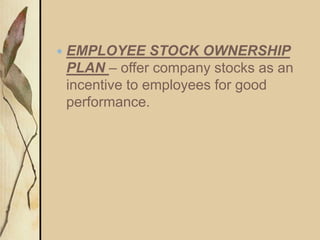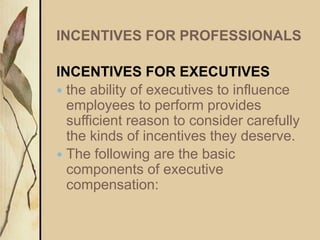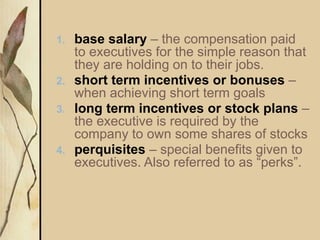INCENTIVE COMPENSATION/human resource.pptx
- 2. What are incentives? ïare rewards given to employees performing beyond the standard requirements. ïAlso referred to as variable pay
- 3. ï Factors to consider in establishing and maintaining incentive systems ï They must be tied to performance. Efforts and rewards must be directly related to each other. It must be fair and desirable. ï They must be designed to cater to individuals who have different needs. This means that there must be a variety of incentives to make sure that a certain type of incentive matches the unique and particular needs of any employee.
- 4. ï They must consider the specific environment and limitations of the organization. ï They must be reviewed periodically to find out if they are still effective. Changes are necessary if the incentive system is not encouraging employees to perform as expected.
- 5. Types of Incentives ï Individual incentive plan ï Group incentive plan ï Organizational incentive plan
- 6. INDIVIDUAL INCENTIVE PLANS ïare those designed to motivate the individual employees to perform beyond standard requirements. Requisite: ï Individual contribution must be the emphasis of the organization. ï The job must be designed to allow the individual employees to work independently and with autonomy and discretion.
- 7. Individual incentive plans may be classified into the following: 1.Piece rate system ï pays individual employees based on the number of units produced by each. It is either straight or differential. ï Straight piece rate plan pays employees a certain rate for each unit produced. ï Differential piece rate plan, two rates are established: one for production within standard and another one for production above standard.
- 8. 2.Commissions ï is a form of incentive usually paid to sales employees. It is based on a percentage of sales in units or pesos. ï it is maybe paid using any of the two arrangements: âĶ straight commission â the employee receives as an incentive the total amount of sales made times his rate. âĶ A small salary plus a commission â when the employee exceeds the budgeted sales goal.
- 9. 3.Bonuses - an extra pay payment given to employees for good performance. 4.Merit pay â as individual pay increases based on the rated performance of individual employees in a previous time period.
- 10. GROUP INCENTIVE PLANS ï are those designed to reward work teams, project members, or departments. Instead of individual output, the emphasis of group incentive is on group output. ï Teamwork is encouraged and poor performers are under pressure from other group members.
- 11. ORGANIZATIONAL INCENTIVE PLANS ï are rewards designed to cover all employees in an organization. Organization â wide incentive plan consist of gain sharing, profit sharing, and employee stock ownership.
- 12. GAIN SHARING PLANS â these are company wide group incentive plans that provide additional pay to employees based on group performance. ï the objective of this is to motivate the employees to increase production or reduce costs.
- 13. ï PROFIT SHARING PLANS - are those that reward employees using the profits of the enterprise as basis. Just like gain sharing plans, groups rather than individuals are rewarded.
- 14. Profit sharing plans may be distinguished according to how they are distributed: 1. Deferred plans â where the individualâs shares in the profits are distributed at retirement. 2. Distribution plans â where the individualâs shares in the profits are distributed after profits are declared. 3. Combination plans â where part of the shares in the profits are distributed at retirement and the remainder as soon as the profits are declared.
- 15. ï EMPLOYEE STOCK OWNERSHIP PLAN â offer company stocks as an incentive to employees for good performance.
- 16. INCENTIVES FOR PROFESSIONALS INCENTIVES FOR EXECUTIVES ï the ability of executives to influence employees to perform provides sufficient reason to consider carefully the kinds of incentives they deserve. ï The following are the basic components of executive compensation:
- 17. 1. base salary â the compensation paid to executives for the simple reason that they are holding on to their jobs. 2. short term incentives or bonuses â when achieving short term goals 3. long term incentives or stock plans â the executive is required by the company to own some shares of stocks 4. perquisites â special benefits given to executives. Also referred to as âperksâ.
